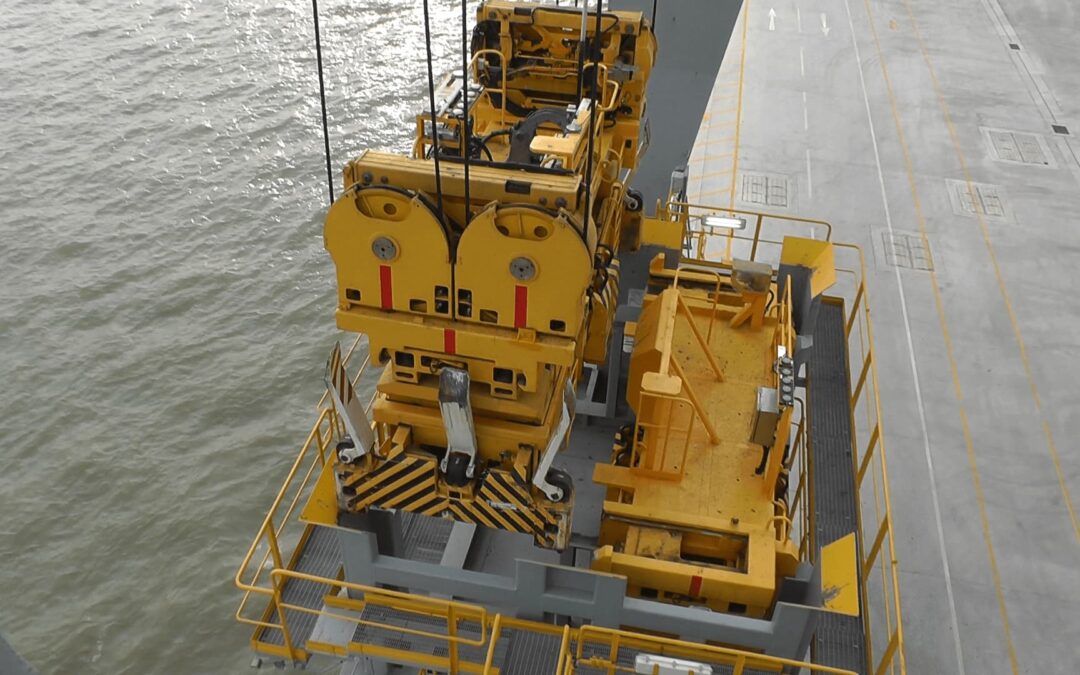As the demand for moving more containers in less time increases, ports and terminals are turning to tandem lift operations to increase their container throughput. But what should terminals be looking for when choosing a tandem system for their operations? Especially for transhipment terminals that perform many mode changes between single and twin spreaders during busy and complex lifting schedules.
A crucial factor – speed and method of spreader change-over
One of the most important factors when choosing the right tandem headblock system is the speed and the method of transition between spreaders (single to twin spreader or twin to single spreader). RAM, which has for many years, been at the forefront of innovation, has been providing a ship to shore crane headblock system called “SingFlex” that performs spreader change-over at the push of a button, in a record-breaking 46 seconds, when placed in the purpose-built docking station located on the sill beam of the crane.
How does SingFlex help terminal operators?
As the process of switching between single and twin spreaders takes place in the docking station at the touch of a button, no ground staff are required to assist in the transition. This means the change-over is done quicker and safer, leaving the crane operator the ability to move more boxes per hour, without risk to the safety of ground staff.
Whilst the concept of tandem lifting is the same with other tandem headblock systems, with twin lift spreaders side by side, the method and speed of change-over differ considerably. Some tandem systems need trailer transportation of the second spreader brought to the quayside, others require detachment of headblock and single spreader before re-attaching both spreaders to the headlock. These methods are labour intensive and time-consuming.
SingFlex – quick and simple
Consisting of a primary and secondary headblock, the single spreader on SingFlex is always connected to the primary headblock for a single spreader twin lift operation. When tandem is needed, the crane operator lowers the single spreader into the docking station located on the sill beam, which contains the secondary headblock connected to the second spreader.
At the push of a button, SingFlex patented sliding mechanism moves and extends the sheaves between the primary and secondary headblock. Once completed (46 seconds), a signal to the crane operator indicates mode change is complete, and the tandem spreaders can be lifted clear from the docking station. The system also works in reverse, changing from tandem to single spreader mode in the same record-breaking time.
Flexible
When speaking to our customers they are often surprised by the flexibility of the headblock system. They note they weren’t aware their crane operator did not have to transition out of tandem (twin spreaders) to lift a single container or to remove a hatch, as it can be done whilst in tandem.
Frequently Asked Questions
What is the main advantage of using tandem lift operations in ports and terminals?
Tandem lift operations allow ports and terminals to move more containers in less time, significantly increasing container throughput.
What should terminals consider when choosing a tandem system?
Terminals, especially transshipment terminals with busy and complex lifting schedules, should consider the speed and method of spreader change-over, transitioning between single and twin spreaders.
What are the safety benefits of using SingFlex headblock in terminal operations?
Since the SingFlex system does not require ground staff assistance for spreader transitions, it enhances safety by reducing the risk to ground personnel and allows crane operators to move more containers per hour efficiently.
How does SingFlex differ from other tandem headblock systems?
Unlike other systems that may require trailer transportation of a second spreader or detachment and re-attachment of spreaders, SingFlex offers a quicker and simpler method with its patented sliding mechanism, reducing labor intensity and time consumption.
What surprises customers about the SingFlex system?
Customers are often surprised by the flexibility of the SingFlex headblock system, particularly its ability to lift a single container or remove a hatch while in tandem mode, without needing to transition out of it. You can read more on the ship to shore crane headblock product page.

